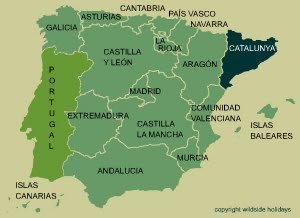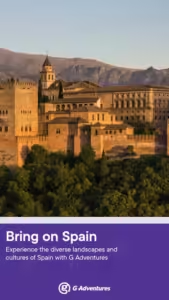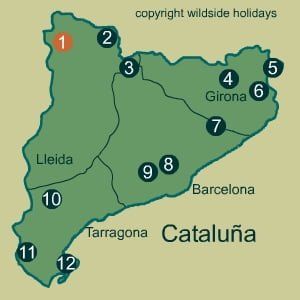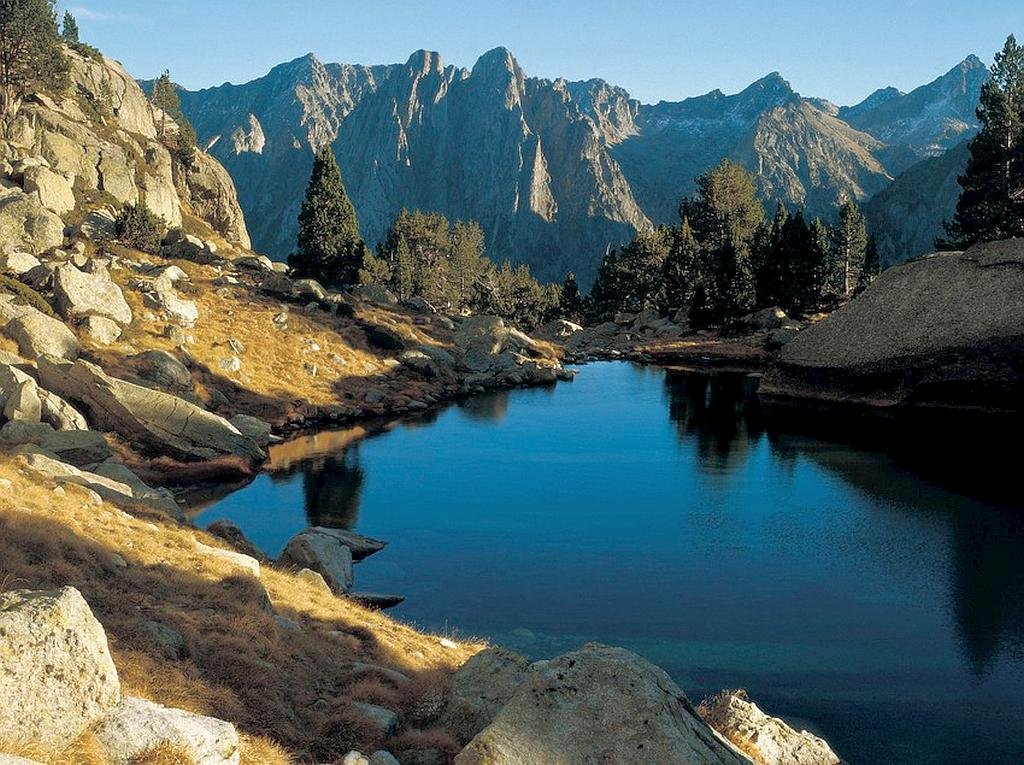Walking and wildlife holidays in Catalonia (Catalunya or Cataluña)
- Capital: Barcelona.
- Area: 32,114 km²
- Provinces 4: Lleida, Girona, Barcelona, Tarragona

Catalunya, also known as Catalonia or Cataluña, sits on the northern edge of Spain and shares borders with Andorra and France at the eastern or Occidental Pyrenees.
The region’s diverse plant life ranges from alpine to Mediterranean, with high meadows giving way to Beech, Holly, Juniper, Cork oaks, and Strawberry trees. In addition to a range of animals such as Wild boar, Fox, Badger, Genet, Beech martin, and Dormouse, Catalunya is also home to the Hermann’s Tortoise, a unique species under protection.
An inactive volcanic landscape found in the north east at La Garrotxa, combines woodland, farmland and nature park with diverse plant life that has both Mediterranean and Atlantic influences due to more precipitation on higher ground.

To the west of Lleida the steppe terrain, an extension from Aragon, attracts different forms of wildlife such as Little Bustard.
Catalonia enjoys a long coastline known to many beach tourists as the Costa Brava and Costa Dorada.
Find a hotel at a natural park in Catalonia – Catalunya – Cataluña
The Parador de Cardona is a unique hotel set within a beautifully preserved 9th-century medieval castle in Catalonia, Spain. It offers guests the rare experience of staying in historic surroundings, complete with ancient stone walls and a Romanesque church, while enjoying modern comforts. Perched above the charming town of Cardona, the Parador provides stunning views of the landscape and easy access to local attractions like the famous salt mountain. It’s an ideal destination for travelers seeking a blend of history, culture, and luxury.
Tours in Catalonia from Viator
Catalonia has a vast array of sites to visit and enjoy. Below are some of the options listed on the Viator website. (We recieve a small commission if you book a tour which doesn’t cost you more and helps us to keep Wildside Holidays up to date with the best information.)
Natural parks in Catalonia

One nature area, the Ebro delta, which flows out south of Barcelona, is the second most important Mediterranean coastal wetland, with the Camargue in France being the first. (Doñana National Park is on the Atlantic coast in Andalusia.)
Protected areas in Catalonia – Catalunya – Cataluña
1 Aiguestortes National Park The Aigüestortes i Estany de Sant Maurici National Park is the only protected area with National Park status in Catalonia. It is located in the central part of the Pyrenees and divided into four regions (Alta Ribagorza, Pallars Sobirá, Pallars Jussá and Valle de Arán) in the province of Lérida.
2 Del Alt Pirineu Natural Park The Alt Pirineu Natural Park is the largest natural park in Catalonia and is located in the Catalan Pyrenees between the Val d’Aran in the west and Andorra to the east. It is interesting to note that all the nearby towns and villages are outside of the parks limits.
3 Cadí Moixeró Natural Park In addition to the outstanding natural beauty of the area, the medieval walls and porticoed square of Bagà, the gothic church and the towers and walls of Bellver de Cerdanya and the rural architecture of the majority of the towns and villages in the area are particularily interesting to visit.
4 La Garrotxa Natural park The Garrotxa Volcanic Zone Natural Park covers a holocene volcanic field (also known as the Olot volcanic field). The volcanos (about forty within the park) are no longer active and the last eruption (Croscat) occurred around 11,000 years ago.
5 Cabo de Creus Natural Park The Natural Park of Cabo de Creus is a peninsula and a headland located at the most northeastern point of the Iberian Peninsula and was the first maritime-terrestrial park created in Catalonia.
6 Aiguamolls de L’Empordà Natural Park There are three nature reserves called Les Llaunes, Els Estany and Illa de Caramany with dune systems, marshes, freshwater ponds, rice fields, reed beds hosting great biodiversity especially in bird life where over 300 species have been recorded and almost 100 species nesting in the area.
7 Macizo de Montseny Natural Park The Macizo del Montseny Natural Park (Just 50 kilometres from Barcelona) is the oldest in Catalonia and is also one of the most important because in a relatively small area there are typical plant communities of the three major European biomes : the Mediterranean (holm oak, cork oak and Aleppo pine), the Eurosiberian (Scots pine, beech and white fir) and boreoalpine (alpine meadow).
8 Sant Llorenc del Munt Natural Park Rugged and rocky, the unique landscape of the area is due to the constant erosion that the rocks are subjected to, resulting in cliffs and monoliths of red conglomerates of outstanding beauty.
9 Macizo de Montserrat Natural Park A multi-peaked mountain range near Barcelona. The main peaks are Sant Jeroni (1,236 m), Montgrós (1,120 m) and Miranda de les Agulles (903 m). This area is well known for the site of the Benedictine abbey Santa Maria de Montserrat and the Virgin of Montserrat sanctuary.
10 Serra de Montsant Natural Park This mountain region is also a famous red wine-producing zone and some of the best vineyards are located near the Cartoixa d’Escaladei, a Carthusian Order monastery.
11 Els Ports Natural Park Now included in the The Tierras del Ebro Biosphere Reserve which was declared by UNESCO in 2013 and is an important protected natural environment containing many ecosystems. It covers the Mediterranean coast up to the mountains and includes also the Delta de l’Ebre and Els Ports natural parks.
12 Delta de Ebro Natural Park holds a great importance internationally as more than 300 species of birds (of the 700 that exist in Europe) have been observed at the Delta. This includes resident, pre and post-nuptial migration as well as wintering flocks. It is the second largest wetland in the western Mediterranean. (The first being the Camargue in France.)
Discover the Wonders of Catalonia’s Natural Parks
Catalonia offers a diverse and breathtaking landscape for nature enthusiasts. From the stunning Pyrenees to the serene Mediterranean coastline, there are numerous natural parks that showcase the region’s rich biodiversity and cultural heritage. Whether you are interested in hiking, birdwatching, or simply enjoying the beauty of nature, Catalonia’s parks provide a perfect escape.
Explore More with Wildside Holidays
We invite you to delve deeper into the natural beauty of Catalonia. Discover detailed guides on various natural parks, learn about the unique wildlife, and find the best spots for your next adventure. Join our community of nature lovers and make your next holiday an unforgettable experience.
For more information on walking and wildlife holidays in Spain, and to stay updated on the latest wildlife news and activities, visit Wildside Holidays and start planning your trip to explore Catalonia’s natural treasures today!
FAQ: Discover Catalonia’s Nature, Wildlife, and Cultural Heritage
Catalonia (Catalunya or Cataluña) lies in northeastern Spain, bordering Andorra and France in the eastern Pyrenees. Its landscape is diverse, ranging from alpine meadows and dense woodlands to steppe terrain near Lleida. The region boasts two famous coastlines: Costa Brava and Costa Dorada. Notably, the La Garrotxa area features an inactive volcanic field with around forty ancient volcanoes. Catalonia’s climate blends Mediterranean warmth with Atlantic influences, creating varied ecosystems.
Catalonia supports a rich variety of wildlife. Mammals like wild boar, foxes, badgers, genets, beech martens, and dormice are common. The Hermann’s tortoise is a protected species here. Birdwatchers flock to wetlands such as the Ebro Delta and Aiguamolls de L’Empordà, home to over 300 bird species, with nearly 100 nesting. The steppe regions near Lleida attract unique species like the little bustard.
Catalonia’s natural parks showcase its ecological and geological diversity:
Aigüestortes i Estany de Sant Maurici National Park: Catalonia’s only national park, set in the Pyrenees.
Alt Pirineu Natural Park: The largest in the region, offering rugged mountain landscapes.
La Garrotxa Volcanic Zone Natural Park: Famous for its volcanic cones and lava flows.
Cabo de Creus Natural Park: A maritime-terrestrial park at the Iberian Peninsula’s northeastern tip.
Aiguamolls de L’Empordà Natural Park: A wetland haven for birds and diverse flora.
Macizo del Montseny Natural Park: A unique blend of Mediterranean, Eurosiberian, and boreoalpine flora.
Delta de Ebro Natural Park: Spain’s second-largest wetland, vital for migratory birds.
Yes, Catalonia’s geology is remarkable. La Garrotxa’s volcanic landscape is home to nearly forty extinct volcanoes. The Montsant massif is known for its rugged cliffs and wine production. Sant Llorenc del Munt features striking red conglomerate cliffs shaped by erosion. The Parador de Cardona, a medieval castle hotel, is near the famous salt mountain, highlighting geological and historical interest.
Catalonia’s flora ranges widely due to its varied climate zones. Alpine meadows in the Pyrenees contrast with Mediterranean forests near the coast. Key species include beech, holly, juniper, cork oaks, and strawberry trees. The Montseny park uniquely supports three major European biomes, including Mediterranean holm and cork oaks, Eurosiberian beech and fir, and boreoalpine alpine meadows.
Beyond nature, Catalonia offers rich cultural experiences. Visitors can explore vibrant cities, enjoy Catalan cuisine, and stay in historic sites like the Parador de Cardona — a beautifully preserved 9th-century castle turned luxury hotel. Wine lovers will appreciate the Montsant region’s vineyards and historic monasteries such as Cartoixa d’Escaladei. The Montserrat massif, with its Benedictine abbey and religious sanctuary, combines natural beauty and spiritual heritage.
Catalonia plays a vital role in Spain’s conservation efforts, with extensive protected areas including a national park and numerous natural parks. The Ebro Delta is one of the Mediterranean’s most important wetlands. UNESCO’s Tierras del Ebro Biosphere Reserve spans diverse ecosystems from coast to mountains. Catalonia’s commitment helps preserve Spain’s geographic diversity, from alpine peaks to Mediterranean shores and volcanic zones.
Wildside Holidays offers comprehensive guides and resources for nature enthusiasts planning a trip to Catalonia. Their website provides detailed information on natural parks, wildlife spotting, walking holidays, and eco-friendly tours. It also features trusted providers and updates on wildlife news, making it easier to plan an unforgettable outdoor adventure in Catalonia and beyond.
About the author of this article.
I’ve been living in this lovely area of Western Andalucia for the last 20 years or so and dedicate most of my time to the running of English language tourist information websites for the towns of Cádiz, Ronda, Grazalema, the famous or infamous Caminito del Rey, and also Wildside Holidays, which promotes sustainable and eco-friendly businesses running wildlife and walking holidays in Spain.

